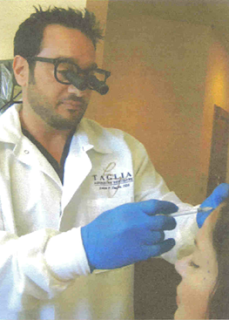With a thriving practice that is nearing the half-century mark, Taglia Advanced Dentistry has built a reputation for quality and care that has inspired loyalty from one generation of patients to the next.
So when Dr. Lou Taglia Jr. first investigated the idea of adding Botox Treatments to his array of services, he was a fierce skeptic. For four years, he was a holdout, reviewing medical literature and studies, discussing the idea with colleagues and even evaluating the experiences of people in his life.
He also heard about a variety of myths. Among them: Botox is a
poison and causes numbness at the point of injection.
poison and causes numbness at the point of injection.
"In fact, it is a purified protein, with no live bacteria, and so it cannot cause an infection," said Taglia. "And there is no numbing effect, because it simply does not have an impact on sensory nerves."
For every critical contention about the perils of Botox, he has found compelling sources debunking them. By June 2009, the doctor couldn't cross his arms any longer.
"I performed my due diligence and the more I looked into it, the more obvious it was that this is a credible, medically safe approach to helping reduce, or even erase, wrinkles," said Taglia. "This helps people age
gracefully. It's an amazing development."
gracefully. It's an amazing development."
Taglia, who already has numerous advanced certifications to treat a wide spectrum of dental problems, gained certification from a leader in the Botox-training field, the Esthetic Skin Institute.
Taglia has now begun providing the treatments at his clinic,
7310 W. North Ave. in Elm wood Park. In short order, the results have been dramatic, with some members of his staff among those that have received treatments and enjoyed significantly reduced wrinkles and a more youthful appearance. Lisa, Taglia's director of patient services, received her first Botox treatment on Sept. 1.
7310 W. North Ave. in Elm wood Park. In short order, the results have been dramatic, with some members of his staff among those that have received treatments and enjoyed significantly reduced wrinkles and a more youthful appearance. Lisa, Taglia's director of patient services, received her first Botox treatment on Sept. 1.
"I never really thought I'd be interested in Botox, but now that I have, it was worth some of the initial discomfort," said Lisa. "I found the results to be quite impressive."
During the five-minute session, she reported feeling some discomfort. But in a follow-up interview a week later, when her face showed a fraction of the wrinkles and fine lines that were apparent before her session,
she raved about the results.
she raved about the results.
Before and After Pictures:
Do you want to view an actual recorded demonstration? Click Here to view.
Botox isn't only for aesthetic reasons, either, as it can help address a wide gamut of symptoms, including
Botox isn't only for aesthetic reasons, either, as it can help address a wide gamut of symptoms, including
TMJ disorders, migraine headaches and excessive sweating, Taglia noted.
Of all the medical fields, dentistry, because of the frequency of injections involved in treating patients is particularly suited to providing Botox—or Botolinum Toxin A, as it is known by its more scientific name.
"When I was undergoing certification training, man of the other doctors in the room had little or no experience with injections," said Taglia. "We're injecting all the time—50 to 100 injections a day. So the transition is much easier for us, we know the facial anatomy extremely well."
According to Arlington Heights-based American Society of Plastic Surgeons, the number of Botox injections went up by 8 percent in 2008, to about five million (there are multiple injections per patient, so the actual
number of individuals is less than five million). The injection tally is more than the next four minimally invasive procedures combined, based on ASPS data.
number of individuals is less than five million). The injection tally is more than the next four minimally invasive procedures combined, based on ASPS data.
Botox works by blocking the nerve muscle that controls muscle movement, restricting the patient's ability to contract facial muscles and resulting in a localized reduction in muscle activity. That, in turn, leads to relaxation of the lines and wrinkles in the treated area, creating a more
youthful-looking appearance that lasts three to six months.
youthful-looking appearance that lasts three to six months.
The exploratory phase of using Botox for medical reasons dates back to 1946. In the 1970s, it began helping some patients with eye problems. In April 2002, the FDA approved its use for treatment of moderate to severe wrinkling in the Glabellar lines, more commonly known as frown lines.
That FDA approval enables Botox's legal use for other areas of the face. Typically, the effect of the treatment shows up one or two days after treatment, peaks between one to four weeks later, and then last for about three or four months before gradually declining.
Please note: Dr. Taglia is an Advanced General Dentist whose service includes the administration of Botolinum Toxin A.



